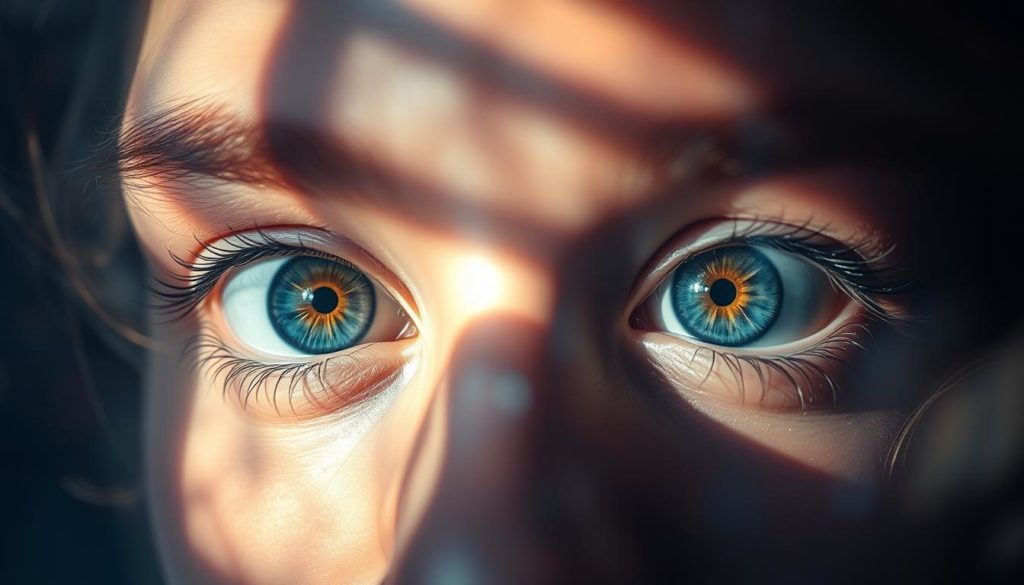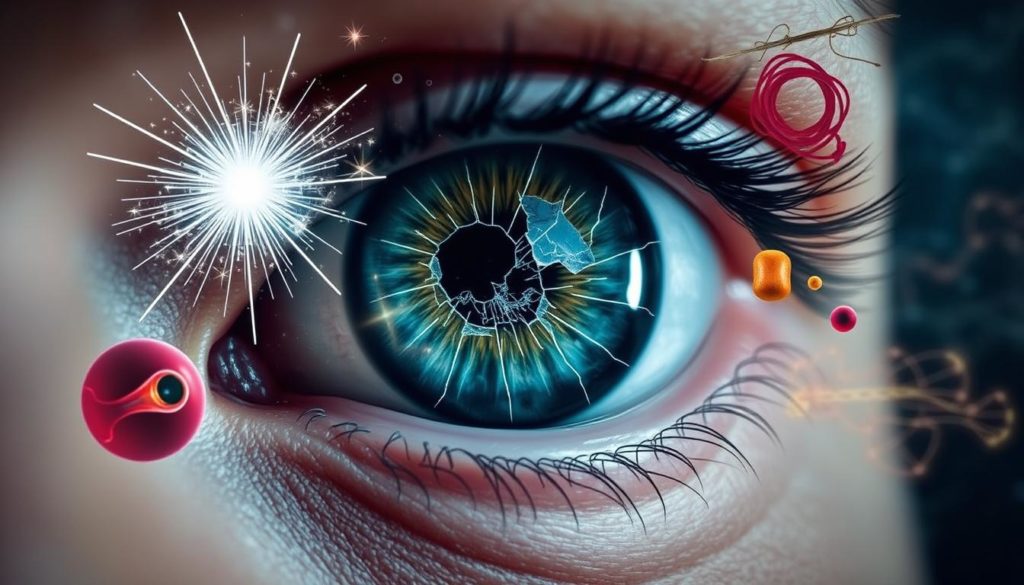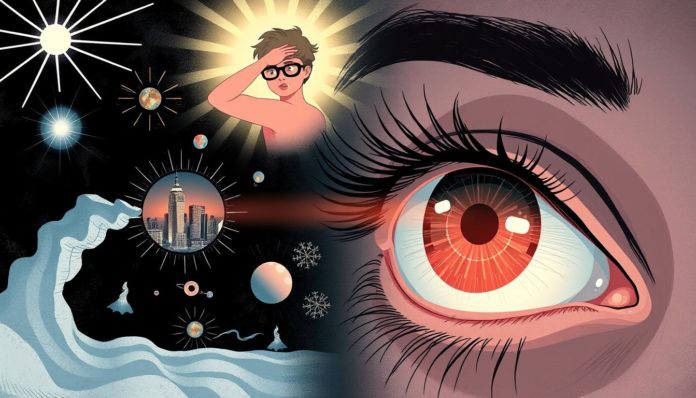Did you know about 1 in 10 people will face temporary blindness sometime? This fact highlights how crucial it is to grasp understanding blindness. Particularly, we need to know its causes and how to find relief. Temporary vision loss is scary but manageable with correct knowledge and actions.
We will explore the different causes of vision loss that aren’t permanent, outline the symptoms, and discuss blindness relief. You’ll learn about specific treatments to general lifestyle adjustments. This will give you a full view on how to handle sudden blindness. Ready to learn how to understand and combat temporary vision problems?
What is Temporary Blindness?
Temporary blindness, or temporary vision impairment, happens when someone can’t see for a short time. This problem often gets better on its own or with care. It’s different from permanent blindness, which can’t be fixed.

There are a few kinds of temporary blindness. Transient blindness lasts from a few seconds to several minutes. Sudden vision loss, however, can happen quickly and last longer but can still be treated.
Knowing the difference between these types is key. Transient blindness may be caused by issues with blood flow to the eye or brain. Sudden vision loss could be due to serious issues like a detached retina or optic neuritis. Recognizing the type helps in getting the right help fast.
What all types of temporary blindness share is that they can be reversed. The time these episodes last can differ. But getting quick and correct care is crucial in returning to normal vision.
Common Causes of Sudden Blindness
Sudden blindness is worrying, with many reasons behind losing sight. Knowing these causes helps catch symptoms early for quick help.

Vascular Problems
Blood vessel problems are a leading cause of loss of vision suddenly. Blockages in these vessels can harm vision greatly.
A stroke can cut off blood to the brain’s vision areas, causing lasting or short-term blindness.
“Ensuring proper blood circulation and managing cardiovascular health play crucial roles in preventing vascular-related vision problems.”
Neurological Issues
Neurological issues like migraines might cause vision troubles. These can lead to eyesight loss that comes and goes.
Multiple sclerosis can also cause blindness by inflaming the optic nerve.
| Neurological Condition | Impact on Vision |
|---|---|
| Migraines | Visual distortions, temporary blindness |
| Multiple Sclerosis | Optic neuritis, vision impairment |
Retinal Detachment
When the retina shifts from its place, it can cause vision loss. This demands quick treatment to avoid long-term blindness.
“Signs of retinal detachment include seeing flashes of light, floaters, or a shadow over your visual field.”
It’s vital to understand the causes of sudden blindness. This includes blood vessel problems, brain issues, and retina shifts. Early action can save sight and improve health.
Symptoms of Temporary Vision Impairment
Understanding temporary blindness symptoms is crucial. The most alarming sign is the sudden loss of vision in one or both eyes. This may happen without warning, causing worry and confusion.
Other key vision changes include lasting blurriness. This makes seeing clearly or reading difficult. Daily activities become challenging. Light sensitivity, or photophobia, is another issue where regular light feels too bright.
Partial vision loss or blind spots are also signs of temporary vision impairment. Spotting these temporary blindness symptoms early is vital. It means people can get the medical advice they need quickly.
Here is a quick rundown of key symptoms to watch for:
- Sudden loss of vision
- Blurriness
- Light sensitivity
- Partial vision loss
- Presence of blind spots
Knowing about these vision changes helps people act fast. They can seek the help needed to protect their eyesight.
When to Seek Immediate Medical Attention
Changes in vision can be scary, but not all need quick medical care. Still, some cases of urgent vision loss signal a serious problem that needs fast action.
It’s crucial to know when to get emergency care for blindness. If you lose your vision suddenly, and it’s severe, it could mean something serious. Symptoms like these could show a stroke, retinal detachment, or other major eye issues. That’s why fast medical help can save your life.
Here are the symptoms to watch for and what to do about them:
| Symptom | Recommended Action |
|---|---|
| Complete vision loss in one eye | Visit the emergency room immediately |
| Sudden, severe eye pain | Seek urgent medical review |
| Flashers or floaters with sudden loss of vision | Emergency consultation with an ophthalmologist |
| Unexplained visual disturbances | Contact a healthcare provider without delay |
Never ignore sudden, big changes in vision. Acting quickly on urgent vision loss can stop more problems and help start the right treatment to protect your eyesight.
Diagnosis of Temporary Eye Blindness
It’s key to know how diagnosing temporary eye blindness works. It allows for quick and right treatment. To find the main problem, doctors look at your medical history, check your vision in different ways, and might use high-tech scans.
Medical History Evaluation
Doctors start by learning about your health history. This step is important to find any health issues that might cause vision problems. They ask about past eye issues, other health problems, medicines, and if your family has had eye problems. Knowing all this is crucial for making a plan that fits you.
Vision Tests
A vision assessment includes several tests. These tests help understand how well you can see.
- Visual acuity tests using eye charts
- Refraction tests to determine prescription needs
- Peripheral vision tests to detect any blind spots
- Color vision tests to assess the ability to distinguish colors
Eye doctors, like ophthalmologists or optometrists, run these tests. They are important to figure out what’s causing the vision loss.
Imaging Studies
Sometimes, you need medical imaging to look at the eye’s insides. MRI or CT scans are key for diagnosing temporary eye blindness. They are especially used if doctors think there’s an injury or something unusual. These scans can show problems that regular exams can’t, helping to understand the loss of vision better.
| Diagnostic Tool | Purpose |
|---|---|
| MRI | To identify neurological causes and structural abnormalities |
| CT Scan | To detect injuries or underlying systemic issues |
| Fundoscopy | To examine the retina and optic nerve |
Combining medical history evaluation, detailed vision assessment, and ophthalmologic examination leads to an accurate diagnosis. This way, doctors can create the best treatment plan.
Treatment Options for Temporary Blindness
The treatment for temporary blindness depends on the cause. Many treatments and strategies exist to help people. Knowing about these options can reduce the worry of losing sight suddenly.
Doctors often use specific drugs to treat temporary blindness. For inflammation, corticosteroids are used. Antiviral drugs help with infections like herpes. These medicines are key in treating vision problems.
- Medications: Anti-inflammatory drugs, antivirals, and antibiotics based on the underlying cause.
- Vision impairment therapy: Tailored rehabilitation programs aimed at improving visual function and adapting to any residual blindness.
Sometimes, surgery is needed. It can fix retinal tears with lasers or clear the vision by removing the vitreous gel. Surgery is a precise way to manage blindness and restore sight.
For tough cases of temporary blindness, a full management plan is essential. It includes assistive tools, occupational therapy, and support groups. These steps help people keep a good quality of life with vision issues.
“The journey to restored vision is multifaceted, requiring a blend of medication, surgery, and adaptive strategies. It’s important to consult with healthcare professionals to determine the best treatment pathway.”
A mix of medical treatments, surgeries, and support helps treat temporary blindness. With the right care, people can get back much of their sight and enjoy life.
| Treatment Option | Description | Use Cases |
|---|---|---|
| Medications | Corticosteroids, antivirals, antibiotics | Inflammation, infections |
| Surgical Procedures | Laser treatments, vitrectomies | Retinal tears, vitreous issues |
| Rehabilitation Programs | Adaptive therapies, assistive devices | Persistent vision impairment |
Preventing Blindness in One Eye
To prevent losing vision in one eye, taking early action is essential. Healthy habits, regular eye exams, and reducing eye strain play a crucial role. These steps help keep your eyes in good shape and prevent blindness.
Healthy Lifestyle Choices
Eating a diet full of vitamins and minerals is key for eye health. Foods rich in omega-3s, lutein, zinc, and vitamins C and E are great. Think leafy greens, fish, nuts, and citrus fruits to boost your vision health. Stopping smoking and controlling chronic diseases like diabetes and high blood pressure are also important.
Regular Eye Exams
Getting your eyes checked regularly is a must to catch problems early. It’s crucial for finding and treating glaucoma, cataracts, and macular degeneration early. Aim for a comprehensive eye exam once a year or more if you already have eye issues.
Avoiding Eye Strain
Limit your screen time and take short breaks during long work sessions. Try the 20-20-20 rule: every 20 minutes, look at something 20 feet away for 20 seconds. Good lighting and ergonomics also help keep your eyes healthy when reading or using devices.
Home Remedies for Mild Cases
Temporary vision loss can be scary. But, there are home remedies to manage it. Eating a balanced diet full of vitamins and antioxidants is key for eye health. Vitamins A, C, E, and zinc help the eyes function well. They may improve recovery. Add foods like leafy greens, carrots, fish, and citrus fruits for a health boost.
Relaxation techniques can help with mild vision problems too. Eye exercises and palming are good methods. Eye exercises include rolling your eyes and focusing on objects far and near. These strengthen the muscles and reduce strain. Palming means covering your eyes with your palms. It gives them a rest in the dark.
It’s important to make your home eye-friendly. Make sure your living spaces have good lighting to avoid eye strain. When using screens, take breaks and adjust settings for comfort. Keeping a good posture while reading or using screens helps prevent vision issues. These steps support eye health and help with faster recovery.
FAQ
What are the main causes of temporary blindness?
Temporary blindness may result from vascular issues like strokes. It can also come from neurological conditions such as migraines. Another cause is retinal detachment. These disrupt vision suddenly and temporarily.
How can I recognize the symptoms of temporary vision impairment?
Signs include sudden vision loss in either eye or both. You might also experience blurriness or light sensitivity. Early recognition of these signs is crucial for timely medical help.
When should I seek immediate medical attention for vision loss?
Seek help immediately if you have sudden vision loss. Extreme light sensitivity and severe blurriness needing urgent care are also red flags. These can indicate a serious issue that demands quick attention.
How is temporary blindness diagnosed?
Diagnosis involves checking your medical history and vision tests. Imaging studies like MRI or CT scans help find the cause. An eye care expert will lead you through this.
What are the treatment options for temporary blindness?
The treatment varies based on the cause. It might include medications or surgery. Your healthcare provider will choose the best way to manage and ease your symptoms.
Are there ways to prevent blindness in one eye?
Yes, a healthy lifestyle and regular eye exams are important. Also, avoiding eye strain is crucial. These steps help spot problems early and keep eyes healthy.
Are there any home remedies for managing mild cases of temporary vision impairment?
For minor issues, nutrition and relaxation help. Proper lighting also makes a difference. Yet, consulting a healthcare expert is always the safest approach.


